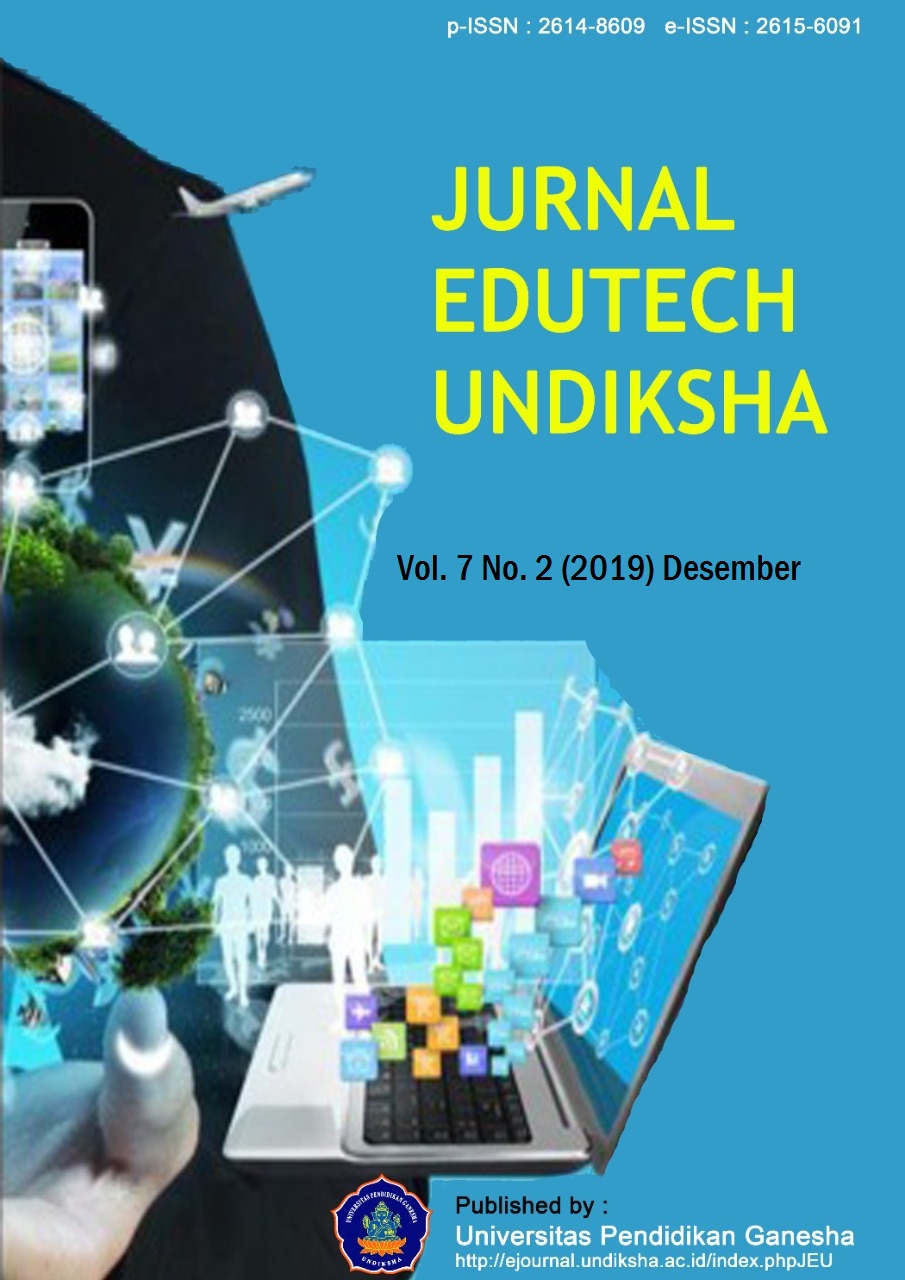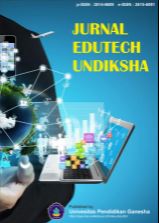PENGEMBANGAN MODUL BERBASIS PENDEKATAN SAINTIFIK UNTUK SISWA KELAS IV SD NEGERI 2 LILIGUNDI
DOI:
https://doi.org/10.23887/jeu.v7i2.21679Abstract
Permasalahan yang terjadi dikelas IV SD Negeri 2 Liligundi adalah kurangnya sumber atau bahan ajar lain yang digunakan oleh guru untuk menunjang pembelajaran di kelas, sehingga hasil belajar siswa kurang maksimal. Tujuan penelitian ini adalah untuk (1) mendeskripsikan proses pengembangan modul berbasis pendekatan saintifik, (2) mendeskripsikan kualitas pengembangan modul IPA berbasis pendekatan saintifik, (3) mengetahui efektivitas modul IPA berbasis pendekatan saintifik. Penelitian ini merupakan penelitian pengembangan. Model pengembangan yang digunakan yaitu model Hannafin dan Peck. Metode pengumpulan data yang digunakan adalah metode observasi, wawancara, kuesioner, dan tes. Analisis data yang digunakan adalah teknik deskriptif kualitatif, deskriptif kuantitatif dan analisis statistik inferensial. Validitas media diuji coba kepada ahli isi mata pelajaran, ahli desain, ahli media, uji coba perorangan, kelompok kecil dan uji coba lapangan Untuk hasil secara berurutan yaitu 95,3 %, 85,2 %, 92%, 94,6%, 96,08%, dan 97,06%. Hasil uji efektifitas yang dianalisis dengan teknik statistik inferensial (uji-t) mendapatkan hasil rata-rata pretest (62,5) < hasil rata-rata posttest (88,3). Setelah dilakukan perhitungan secara manual dengan menggunakan uji-t didapatkan hasil yang menunjukkan thitung (9,521) > dari ttabel dengan db= n1+n2-2 = 10 pada taraf signifikan 5% yaitu 1,812. Jadi thitung > ttabel, maka berdasarkan ketentuan bila t hitung > t tabel maka H0 ditolak dan H1 diterima. Berarti terdapat perbedaan yang signifikan hasil belajar siswa sebelum menggunakan modul berbasis pendekatan Saintifik dan sesudah menggunakan modul berbasis pendekatan Saintifik.Kata Kunci : Model Hannafin dan Peck, modul, hasil belajar.
The problem that occurred in grade IV of SD Negeri 2 Liligundi was the lack of resources or other teaching materials used by teacher to support the learning process in the classroom. So that, student’s learning outcomes were not really optimal. The purpose of this study was to (1) describe the process of developing modules using a scientific approach, (2) describe the quality of a science module development which used a scientific approach, (3) determine the effectiveness of a science module that used a scientific approach. This research was a research development. The development model used was Hannafin and Peck's model. Data collection methods used in this research were observations, interviews, questionnaires, and tests. Analysis of the data used was descriptive qualitative techniques, quantitative descriptive and inferential statistical analysis. The validity of the media was tested on subject matter experts, design experts, media experts, individual trials, small groups and field trials. The results were respectively 95.3%, 85.2%, 92%, 94.6%, 96, 08%, and 97.06%. The results of the effectiveness test were analyzed by inferential statistical techniques (t-test) to obtain an average pretest result (62.5) from the table with db = n1 + n2-2 = 10 at a significant level of 5%, 1,812. So t count> t table, then based on the provisions if t count> t table which could be concluded that H0 was rejected and H1 was accepted. Meaning that there were significant differences in student’s learning outcomes between before and after using modules with scientific approach.
keyword : Hannafin and Peck model, module, learning outcome.
Downloads
Published
2019-11-28
How to Cite
RAHMAN, S., Suwatra, I. I. W., & Sudatha, I. G. W. (2019). PENGEMBANGAN MODUL BERBASIS PENDEKATAN SAINTIFIK UNTUK SISWA KELAS IV SD NEGERI 2 LILIGUNDI. Jurnal Edutech Undiksha, 7(2), 24–35. https://doi.org/10.23887/jeu.v7i2.21679
Issue
Section
Articles
License
Authors who publish with the Jurnal EDUTECH Undiksha agree to the following terms:
- Authors retain copyright and grant the journal the right of first publication with the work simultaneously licensed under a Creative Commons Attribution License (CC BY-SA 4.0) that allows others to share the work with an acknowledgment of the work's authorship and initial publication in this journal.
- Authors are able to enter into separate, additional contractual arrangements for the non-exclusive distribution of the journal's published version of the work (e.g., post it to an institutional repository or publish it in a book), with an acknowledgment of its initial publication in this journal.
- Authors are permitted and encouraged to post their work online (e.g., in institutional repositories or on their website) prior to and during the submission process, as it can lead to productive exchanges, as well as earlier and greater citation of published work. (See The Effect of Open Access)














